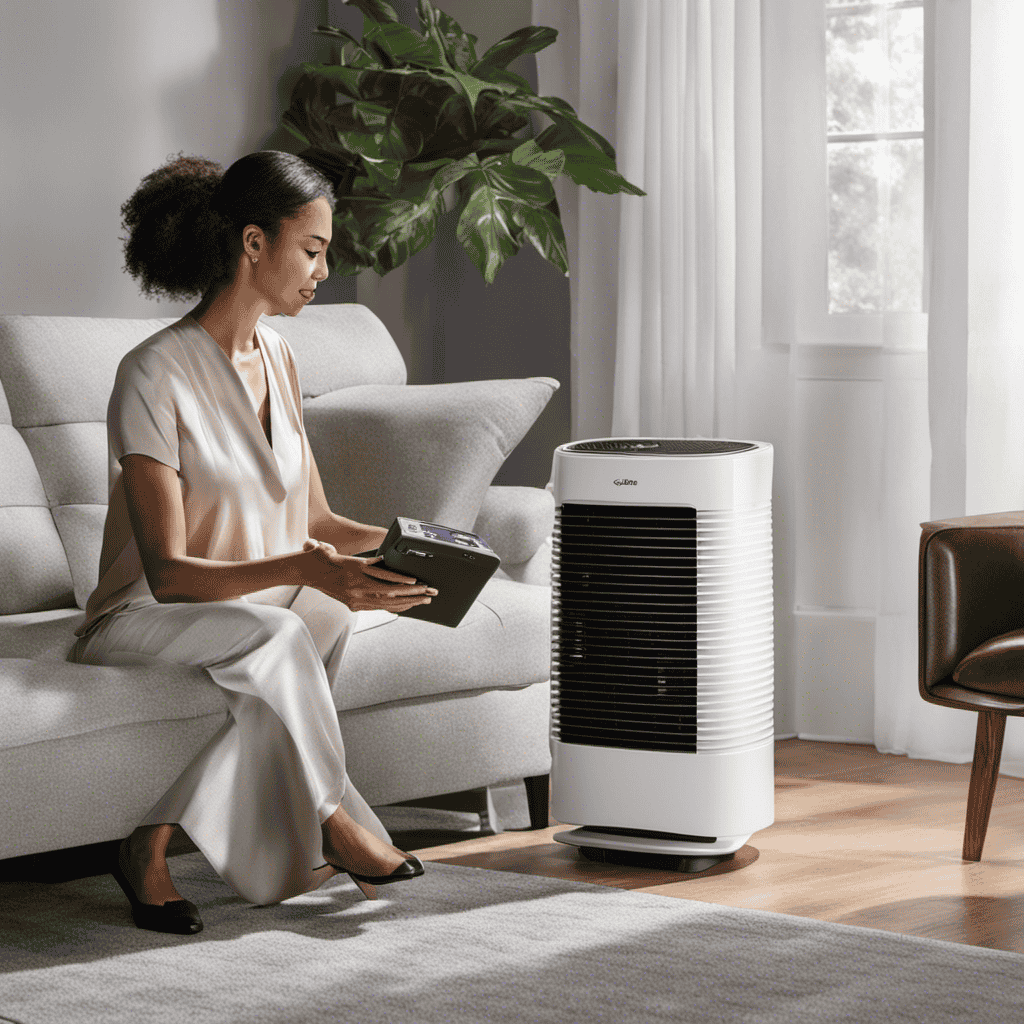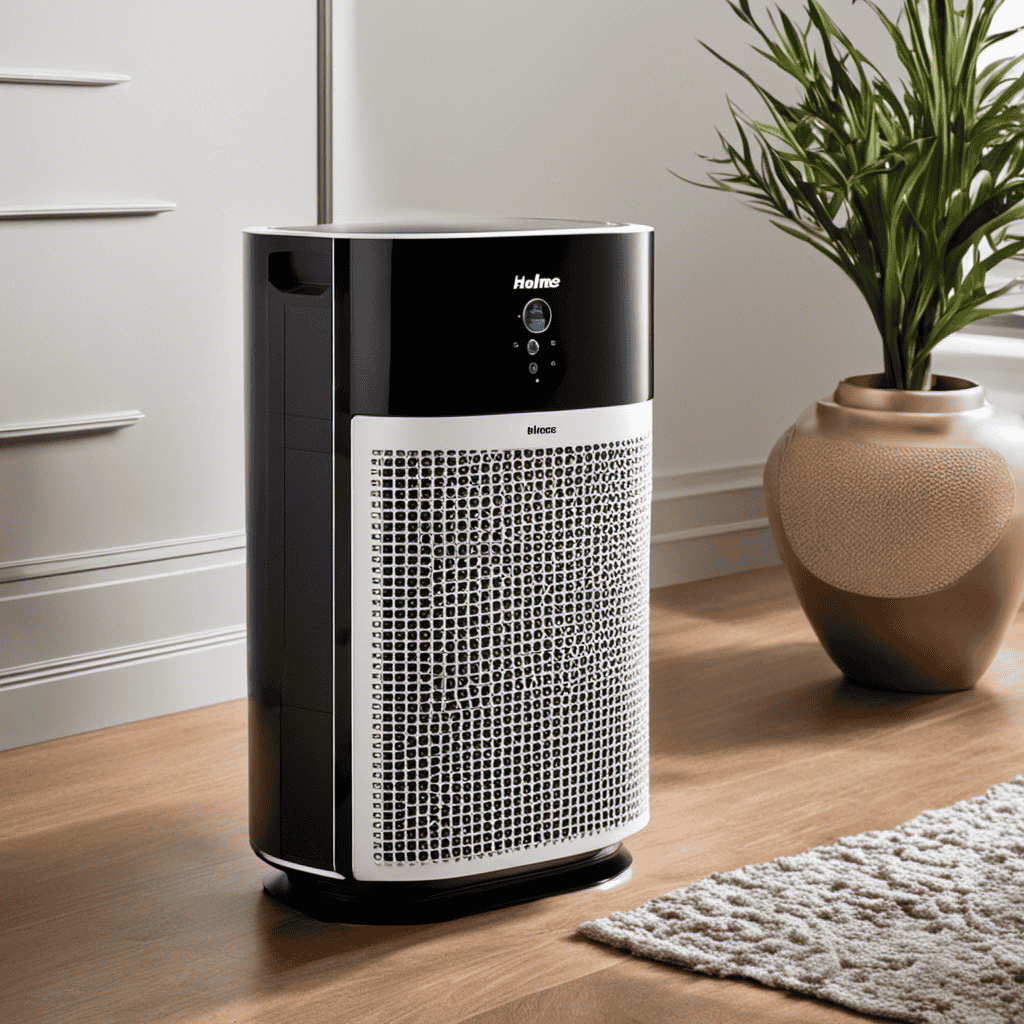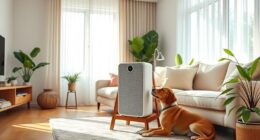In my quest for the ultimate mold-busting air purifier, I stick to a handful of crucial tips.
Like a detective hunting for clues, I search for the right size and coverage area, ensuring that every nook and cranny is protected.
I pay close attention to the filtration system, making sure it’s equipped with a high-efficiency HEPA filter and other advanced technologies.
Plus, I consider the noise level, energy efficiency, and overall value for money.
Let’s dive in and uncover the secrets to finding the ultimate mold-fighting machine!
Key Takeaways
- Consider the recommended room size specified by the manufacturer and ensure the purifier is neither too small nor too large for the room.
- Choose an air purifier with a High Efficiency Particulate Air (HEPA) filter for effective filtration.
- Regularly maintain the air purifier by following the manufacturer’s guidelines and regularly changing filters.
- Look for additional filters and technologies such as carbon filters and UV-C technology to enhance the effectiveness of the air purifier for mold.
Size and Coverage Area
When choosing an air purifier, it’s important to consider the size and coverage area. The performance of an air purifier is directly linked to the recommended room size. A purifier that is too small for the room will not effectively clean the air, while one that is too large may waste energy and not efficiently remove mold particles.
To determine the right size, you should consider the square footage of the room where you plan to use the purifier. Most air purifiers have a recommended room size specified by the manufacturer. This information is crucial as it ensures that the air purifier will be able to effectively clean the air in your specific space.
Now, let’s move on to the next important aspect of choosing an air purifier – the filtration system.
Filtration System
The filtration system in an air purifier is crucial for removing mold spores from the air. Mold spores can be a major allergen and can even cause respiratory issues in some individuals. Therefore, it is important to choose an air purifier with an effective filtration system to ensure clean and healthy air in your home.
Here are two key factors to consider when looking for an air purifier with an effective filtration system:
-
HEPA Filter: Look for an air purifier that features a High Efficiency Particulate Air (HEPA) filter. HEPA filters are designed to capture particles as small as 0.3 microns, including mold spores. Make sure the air purifier you choose has a true HEPA filter, as this will ensure the highest level of filtration.
-
Maintenance: Regular air purifier maintenance is essential to ensure its effectiveness in filtering mold spores. Check the manufacturer’s guidelines for filter replacement and cleaning instructions. Regularly changing the filters and cleaning the unit will help maintain optimal air filtration and prolong the lifespan of the air purifier.
HEPA Filter Efficiency
When it comes to mold removal effectiveness, it’s crucial to consider the long-term cost savings. As someone who has dealt with mold issues in the past, I’ve learned that simply getting rid of visible mold is not enough.
It’s essential to address the root cause of the problem and ensure that the mold does not return, saving both time and money in the long run.
Mold Removal Effectiveness
A high-quality air purifier with a HEPA filter is effective at removing mold particles from the air. Mold spores are tiny particles that can cause various health issues when inhaled. By using an air purifier with a HEPA filter, you can prevent the spread of mold spores and improve the air quality in your home or office.
Here are some key benefits of using an air purifier for mold removal:
-
Eliminates mold spores: The HEPA filter in the air purifier captures and traps mold spores, preventing them from circulating in the air.
-
Reduces respiratory issues: Mold spores can trigger allergies and respiratory problems. By removing them from the air, an air purifier can help alleviate these symptoms.
-
Prevents mold growth: By eliminating mold spores, an air purifier can help prevent the growth of mold in your living space, reducing the risk of mold-related health issues.
Investing in a high-quality air purifier with a HEPA filter is an effective way to ensure mold spore prevention and enjoy the health benefits of clean air.
Long-Term Cost Savings
Investing in a high-quality air purifier with a HEPA filter can save you money in the long run. Not only does it help improve indoor air quality by removing mold spores, but it also has the potential to provide health benefits. Additionally, these air purifiers are energy-efficient, which can help reduce your energy consumption and lower your utility bills. To help you understand the long-term cost savings of investing in an air purifier, here is a comparison table showcasing the potential benefits:
| Benefit | Description |
|---|---|
| Energy Savings | Energy-efficient air purifiers consume less electricity, resulting in lower energy costs. |
| Health Benefits | Cleaner air can reduce the risk of respiratory issues and allergies, leading to fewer medical expenses. |
| Maintenance Costs | High-quality air purifiers with HEPA filters require minimal maintenance, saving you money on replacements and repairs. |
Additional Filters and Technologies
Make sure you consider the additional filters and technologies available in air purifiers for mold, such as HEPA filters and UV-C light, to ensure you’re effectively removing mold spores from the air in your home.
When it comes to air purifiers for mold, two important features to look for are a carbon filter and UV-C technology.
-
Carbon filter: This filter is designed to capture and remove odor-causing molecules and volatile organic compounds (VOCs) from the air. Mold can release musty odors, so a carbon filter can help eliminate these unpleasant smells.
-
UV-C technology: UV-C light is a powerful tool for killing mold spores and other microorganisms. It works by damaging the DNA of these organisms, preventing them from reproducing. This technology can be highly effective in reducing the presence of mold in the air.
Noise Level
Consider the noise level of air purifiers with carbon filters and UV-C technology to ensure a quiet and peaceful environment in your home. When buying an air purifier, it’s important to take into account the decibel levels of the device. A loud air purifier can be disruptive and make it difficult to concentrate or relax. Look for air purifiers that advertise "quiet operation" or have specific decibel level information provided by the manufacturer. To help you make an informed decision, here is a table comparing the decibel levels of popular air purifiers on the market:
| Air Purifier Model | Decibel Level |
|---|---|
| Model A | 30 dB |
| Model B | 35 dB |
| Model C | 40 dB |
Energy Efficiency
When considering the energy efficiency of air purifiers, it’s important to look for cost-saving energy features that can help reduce electricity consumption and save on utility bills.
Some key features to consider include programmable timers, energy-saving modes, and sensors that detect air quality and adjust the fan speed accordingly.
Additionally, conducting an environmental impact assessment can provide valuable insights into the long-term sustainability of the air purifier. This assessment can include evaluating the materials used in its construction, its energy consumption, and its potential for recycling or disposal.
Cost-Saving Energy Features
One thing to check for when buying an air purifier for mold is if it has cost-saving energy features like an auto-off timer or energy-efficient mode. These features not only help in saving electricity but also reduce your overall energy consumption.
When it comes to cost-saving energy features, there are a few options to consider:
-
Auto-off timer: This feature allows you to set a specific time for the air purifier to turn off, helping you save energy when you’re not using it.
-
Energy-efficient mode: Some air purifiers have a mode specifically designed to consume less energy while still effectively purifying the air.
Environmental Impact Assessment
To assess the environmental impact, you should check if the air purifier uses eco-friendly materials and has been certified by recognized environmental organizations. When considering sustainability benefits, it is important to choose an air purifier that not only improves indoor air quality but also minimizes harm to the environment. Look for certifications such as Energy Star and the Green Seal to ensure that the air purifier meets strict environmental standards. Additionally, consider the materials used in the construction of the purifier. Opt for models that use recycled or sustainable materials to reduce waste and promote sustainability. By choosing an environmentally friendly air purifier, you can improve your indoor air quality while minimizing your ecological footprint.
| Eco-friendly Air Purifier | Benefits |
|---|---|
| Uses sustainable materials | Reduces waste |
| Certified by recognized environmental organizations | Promotes sustainability |
| Energy-efficient | Lowers energy consumption |
| Minimizes environmental impact | Improves indoor air quality |
Considering the environmental impact of an air purifier is crucial for promoting sustainability and reducing harm to the planet. By choosing an eco-friendly model, you can enjoy the benefits of improved indoor air quality while also contributing to a healthier environment. Now, let’s explore the importance of maintenance and filter replacement in ensuring the effectiveness of your air purifier.
Maintenance and Filter Replacement
Make sure you regularly check and replace the filters in your air purifier to ensure it effectively removes mold particles from your home. Regular cleaning and maintenance are crucial for the optimal performance of your air purifier.
Here are some important points to consider:
-
Regular cleaning:
-
Dust and clean the exterior of the air purifier to prevent the buildup of dirt and allergens.
-
Vacuum the pre-filter to remove larger particles and debris that may clog the filter.
-
Filter lifespan:
-
Check the manufacturer’s instructions to determine the recommended filter replacement schedule.
-
Some filters can last up to 6 to 12 months, depending on the usage and air quality in your home.
Price and Value for Money
After discussing the importance of maintenance and filter replacement in the previous section, it’s time to consider the price and value for money when buying an air purifier for mold. When investing in an air purifier, it’s essential to find a balance between cost and quality. To help you make an informed decision, I have created a table below highlighting key features and brand reputation of popular air purifiers on the market:
| Air Purifier Model | Key Features | Brand Reputation |
|---|---|---|
| Model A | HEPA Filter, UV-C Light, Activated Carbon Filter | Highly Rated |
| Model B | True HEPA Filter, Ionizer, Smart Sensors | Trusted Brand |
| Model C | HEPA-Type Filter, Carbon Filter, Night Mode | Affordable Option |
Frequently Asked Questions
Are Air Purifiers Effective in Removing All Types of Mold Spores?
Yes, air purifiers with HEPA filters are effective in removing most types of mold spores. Additionally, air purifiers with UV C technology can provide further benefits by neutralizing airborne mold spores.
Can Air Purifiers Completely Eliminate the Presence of Mold in a Room?
Air purifiers are effective in reducing mold spores, but they have limitations in completely eliminating mold. While they can improve air quality, it’s important to address the root cause of mold growth for a long-term solution.
How Often Should the Filters in an Air Purifier Be Replaced to Maintain Its Effectiveness Against Mold?
When it comes to air purifiers for mold, it’s important to consider the replacement frequency of the filters. Regularly replacing filters is key for maintaining the effectiveness of the purifier against mold and ensuring clean air.
Are There Any Specific Air Purifiers That Are Recommended for People With Mold Allergies?
When it comes to mold allergies, there are specific air purifiers that are recommended. The best air purifiers for mold prevention are ones that have HEPA filters and activated carbon filters.
Can Air Purifiers Be Used in Conjunction With Other Mold Prevention Measures, Such as Dehumidifiers or Mold-Resistant Paint?
Using air purifiers in conjunction with other mold prevention measures, such as dehumidifiers or mold-resistant paint, can greatly enhance the effectiveness of mold prevention. The benefits of using mold-resistant paint alongside air purifiers are numerous and well-documented.
Conclusion
After carefully considering all the factors, I have come to the conclusion that finding the right air purifier for mold is crucial for a healthy and clean indoor environment.
With the right size, filtration system, and filter efficiency, you can effectively remove mold spores from the air. Additional filters and technologies can provide extra protection.
Remember to consider the noise level, energy efficiency, and maintenance requirements. Lastly, don’t forget to compare prices and value for money.
So, which air purifier will you choose to ensure mold-free air? The suspense builds as you make this important decision.










